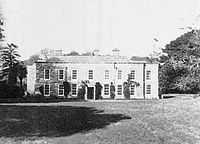Menabilly
Coordinates: 50°19′44″N 4°40′12″W / 50.329°N 4.670°W



Menabilly (Cornish: Men Ebeli, meaning stone of colts) is an early Georgian house, on the site of and possibly incorporating parts of an earlier Elizabethan house, near Fowey, on the south coast of Cornwall, England. It received a Grade II* listing on 13 March 1951.[1] It has long been the seat of the Rashleigh family. It is situated on the Gribben peninsula about 2 miles (3.2 km) west of Fowey.[2] The house is surrounded by woodland. Nearby is the farmhouse Menabilly Barton.[3] In the Return of Owners of Land, 1873 Mr Jonathan Rashleigh of Menabilly Estate, Par, was listed as the largest landowner in Cornwall with an estate of 30,156 acres (122.04 km2) or 3.97% of the total area of Cornwall.[4]
The house inspired one-time tenant, Daphne du Maurier, to write her bestselling 1938 novel Rebecca, in which the house features as "Manderley".
Rashleigh family seat

The Rashleighs of Menabilly, Fowey, Cornwall, were powerful merchants in the time of King Henry VIII and Queen Elizabeth I. In 1545 Philip Rashleigh (d.1551), a younger son of the family from Barnstaple in Devon, who had become wealthy through trade, purchased the manor of Trenant close to Fowey from the King after the Dissolution of the Monasteries. His two sons Robert and John founded the Rashleighs of Fowey. The land on which Menabilly was built has been owned by the Rashleigh family since the 1560s. In 1589 John Rashleigh commenced building the mansion which was completed in 1624 by his son Jonathan Rashleigh (1591-1675). It was re-built between 1710 to 1715 by Philip Rashleigh. The present house is of two storeys built around a central courtyard with a six-bay front on which the central 3 bays break forward.[5]
Philip Rashleigh landscaped the gardens and planted the woodland around the house and estate. William Rashleigh, his nephew, succeeded after Philip's death in 1811. In 1822 a fire broke out which led him to greatly extend the house. During these alterations, his architect noticed that the buttress against the north wall was not really supporting anything and so had it demolished. Upon this they discovered steps leading to a small cell where they found the body of a Cavalier, and when William researched this he discovered that certain members of the Grenville family had sought sanctuary from the Parliamentarian forces during the civil war. Jonathan Rashleigh (1820-1905) improved and extended the gardens and grounds surrounding Menabilly. He planted many trees including pines, cedars, eucalyptuses and beeches. He also planted rhododendrons, bamboos and hydrangeas.John Rashleigh, grandson of Jonathan, succeeded in 1905 and rarely lived at Menabilly which thus fell into serious decay. It was discovered in a dilapidated state by the author Daphne du Maurier who when granted a lease in 1943, set about restoring it and living in it before returning it to the Rashleighs in 1969.[6]
Menabilly in the 21st century
Today, Menabilly and most of the grounds remain private although two cottages on the estate are rented as holiday lets.
In popular culture
The house was the inspiration, along with Milton Hall, Cambridgeshire, for "Manderley", the house in du Maurier's novel Rebecca (1938).[7] Like Menabilly, the fictional Manderley was hidden in woods and could not be seen from the shore. Also du Maurier's novel "The Kings General" is set here and features the skeleton found in the cellar.
External links
Further reading
- Rashleigh, E.W., Book of Pedigrees, Cornwall Record Office: RS/86
- Marshall, James C., Rashleigh of Devon, Devon Notes & Queries, Vol. IV (1906/7), pp. 201–16
References
- ↑ Listed buildings text
- ↑ Ordnance Survey: Landranger map sheet 200 Newquay & Bodmin ISBN 978-0-319-22938-5
- ↑ Menabilly Barton situated at at grid reference SX 100 511
- ↑ Who Owns Britain - by Kevin Cahill (author)
- ↑ Listed buildings text[citation needed]
- ↑ Oriel Malet (ed.), (1993) Letters from Menabilly, Weidenfeld & Nicolson.
- ↑ http://www.dumaurier.org/memories.html
| ||||||||||||||||||||